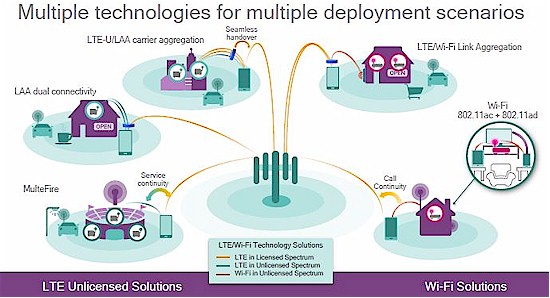
LTE and Wi-Fi. Better Together?
Introduction
Last month, T-Mobile announced plans to roll out LTE-U technology somewhere in the U.S. this spring. This means this controversial technology that has brewing since 2013 is finally going to become real for some of us, real soon. T-Mobile hasn’t provided details about where in the U.S. LTE-U will be deployed, so we don’t yet know who the lucky winners will be.
I have enough to do keeping up with the developements in consumer Wi-Fi, so haven’t been tracking the LTE-U vs. Wi-Fi debate that closely. But now that it’s about to poke its nose under the Wi-Fi tent, it’s time to get a better handle on whether the technology is really going to play as nice with Wi-Fi as Qualcomm and other boosters of this new mobile network technology would have us believe.
What Are We Talking About?
Mobile carriers have had great success in getting us hooked on mobile video streaming. They’ve been so successful that they’ve oversold network capacity in many cases, which results in slower and less reliable connections and unhappy customers.
The approach to solving this problem until now has relied on moving data traffic to Wi-Fi networks, aka Wi-Fi offload. Many of us already use Wi-Fi offload whenever we can to avoid using expensive data minutes. Even folks with "unlimited" plans do this to avoid getting throttled down to a crawl when they hit their their oxymoronic "unlimited" data cap.
Various Wi-Fi offload methods are used depending on mobile provider, location and even internet service provider. But all suffer from the fact that the Wi-Fi networks that carriers are depending on to offload traffic aren’t under their control. As a result, "automatic" offload methods often don’t offer the seamless experience carriers would like. The net result is most of us handle switching to Wi-Fi manually.
The basic premise behind LTE-U and its related technologies is to put the use of unlicensed (Wi-Fi) 5 GHz spectrum under mobile carriers’ control. This lets carriers make using the 5 GHz Wi-Fi band as invisible to mobile users as any other of the many licensed bands it already uses.
Technologies
LTE-U isn’t the only technology looking to share unlicensed 5 GHz spectrum. The image below, taken from a Qualcomm infographic, shows the three major technologies in play. You’ll often see references to LTE-U and LAA and more often, LTE-U / LAA. But, while similar, LTE-U and LAA are not the same.

Three ways mobile networks can use unlicensed spectrum
LTE (Long Term Evolution) – This is the base 4G technology developed by 3GPP (3rd Generation Partnership Project), the consortium that developed the GSM mobile network standard. Release 8 was the first LTE release.
LTE-U (LTE in Unlicensed spectrum) – This is the first pass at technology that uses the 5 GHz unlicensed band for mobile network traffic. It was initially developed by Qualcomm, based on the 3GPP LTE standard. The full specification was developed by the LTE-U Forum, an industry consortium formed by Verizon, Qualcomm and others in 2014. You can think of LTE-U as the time-to-market version of the more universal standard, LAA. LTE-U will be the first to be deployed in the US, Korea and India.
LAA (License Assisted Access) – This is the "global standard" version of the technology developed by the 3GPP, defined in 3GPP Release 13 (Q1 2016). No U.S. carriers have officially announced LAA deployments as yet. But it is thought LTE-U networks will eventually migrate to LAA.
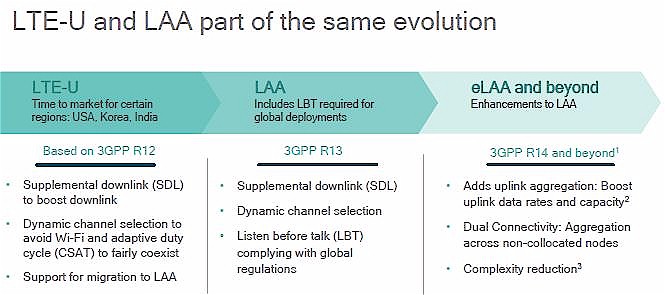
Migration timeline
A key difference between LTE-U and LAA lies in the mechanism used to share bandwidth with 5 GHz Wi-Fi. LTE-U uses a mechanism called Carrier-Sensing Adaptive Transmission (CSAT), while LAA uses a mechanism called Listen Before Talk (LBT). The Qualcomm folks I spoke with for background in preparing this article tried patiently to explain the difference not only between CSAT and LBT, but also between the CSMA/CA mechanism Wi-Fi devices use to make sure they’re not transmitting at the same time. This Qualcomm whitepaper may help you understand the difference better than it helped me.
My main takeaway is that LBT is required in Europe and other regions using ETSI standards, so that’s what LAA must use. LBT is not required in the US, Korea and India, which is why LTE-U (with CSAT) can be used in those countries. Proponents of each say their technology will ensure fair bandwidth sharing with Wi-F and have run trials to prove it (here’s one). But the proof will be in the verification.
LWA (LTE + Wi-Fi Link Aggregation) – An alternate approach to combining LTE and unlicensed networks that is also defined in 3GPP Release 13. 5 GHz band Wi-Fi is used to carry downlink traffic only. LTE carries all uplink, optionally downlink and manages both connections.
The graphic below taken from this Qualcomm presentation nicely illustrates LTE-U, LAA and LWA. LTE in licensed spectrum is combined with technologies in unlicensed spectrum in all three methods. The key difference is how the unlicensed spectrum is used, which will be explained further shortly.
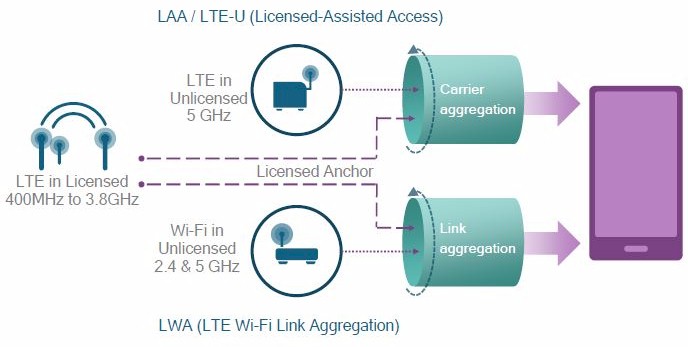
Two ways to combine LTE and Wi-Fi
MulteFire – LTE technology operating solely in unlicensed spectrum. This is another mobile technology created by Qualcomm to enable LTE networks to operate in unlicensed spectrum. This doesn’t seem close to deployment at this time. It could be a contender for use in the unlicensed 3.65 GHz – 3.70 GHz band. It could also be used in the 5 GHz Wi-Fi band in campus type deployments. Qualcomm would like us to think of MulteFire as a more efficient way to use the 5 GHz band than 5 GHz Wi-Fi.
So What’s the Problem?
As you read through this section, keep in mind that the 5 GHz frequencies / channels at the heart of the LTE-U/LAA vs. Wi-Fi debate are unlicensed spectrum. This means it is free for anyone to use without a license from a regulatory authority (the FCC in the U.S.) as long as certified equipement is used and technical requirements are followed.
Although the Wi-Fi industry has reaped the most benefit from the 2.4 and 5 GHz unlicensed bands, there is no law or regulation that says they are sole users of the spectrum. Many other devices including cordless phones, baby monitors, wireless cameras and even microwave ovens also share the space. Mobile network operators now simply want to use it too.
The nut of the problem is that LTE-U and LAA use standard 5 GHz Wi-Fi channels, i.e. 36-48 and 149-165 in the U.S., but not Wi-Fi protocols. Since Wi-Fi devices don’t understand LTE-U / LAA protocols, they can’t detect that LTE-U or LAA networks are in operation or properly contend for air time.
This puts the burden of fairly sharing 5 GHz Wi-Fi airtime solely on LTE-U / LAA devices. Wi-Fi devices can’t participate in the sharing mechanism with LTE-based services because they can’t understand LTE protocols. This is a situation similar to the introduction of 802.11n Wi-Fi; 11b and g devices didn’t "speak" 11n. So 802.11n had to have mechanisms to accommodate "legacy" protocols, which it could detect.
Fair bandwidth sharing is the core issue that has been argued since Qualcomm first birthed LTE-U. It’s probably how you first heard of LTE-U, and most likely in negative terms, as a technology out to "steal" 5 GHz Wi-Fi network bandwidth or kill the band altogether.
Qualcomm and unlicensed LTE proponents have said their technologies would not adversely affect Wi-Fi networks. And many trials and studies have been done to prove fair sharing. But with a global Wi-Fi market predicted to be $33.6B by 2020 vs. a 2016 global smartphone market alone worth $429B, you could see why Wi-Fi folks were not inclined to believe unlicensed LTE forces had their best interests in mind.
Since all parties wanted to avoid a legislated solution, they came to the bargaining table. The upshot was that the Wi-Fi Alliance, which for some reason was considered to be a neutral trusted party, was charged with developing a LTE-U / Wi-Fi Coexistence Test Plan that was unveiled in September 2016. We’ll get to some of its details shortly. But the guiding principle for the test plan were stated in the Coexistence Guidelines document:
A deployed system transmitting in an unlicensed channel is operating fairly to Wi-Fi if the impact of that system on Wi-Fi users in the channel is no worse than the impact that would result from an additional Wi-Fi device or Wi-Fi network [emphasis mine] introduced into the channel supporting the same traffic load as the system.
A technology capable of being used in unlicensed channels is fair to Wi-Fi if its deployed implementations will always operate fairly as described above.
Note the Wi-Fi Alliance test plan is for LTE-U equipment only. 3GPP, the group developing the LAA specificiation is also developing an LAA coexistence verification plan.
Use of the Wi-Fi Alliance Coexistence Test Plan, however, is completely voluntary. T-Mobile and Verizon have publicly stated they will use the plan before deploying any LTE-U equipment. But I could find no similar statements from AT&T, Sprint or other U.S. carriers.
How Will LTE-U / LAA Play Fair?
So an LTE-U / LAA network will behave no worse than a neighboring 5 GHz network? Actually, in many cases LTE-U or LAA may be friendlier because it is designed to be, using three coexistence mechanisms illustrated in the flow diagram below.
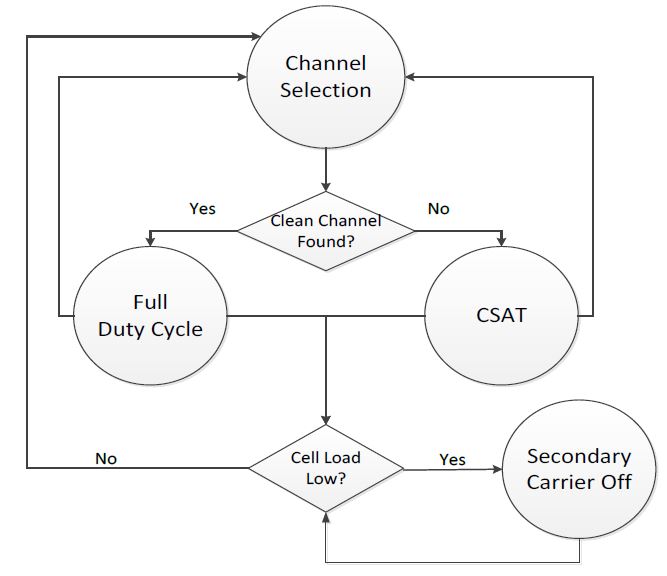
LTE-U coexistence algorithm flow chart
(from Qualcomm Harmonious Coexistence with Wi-Fi whitepaper)
- Channel selection – Unlicensed LTE will always try to find an unused channel first. Channel utilization is also monitored on an on-going basis and the channel will be changed if a better channel (lower use) is found.
- Adaptive channel use – Unlicensed LTE trasmission on / off duty cycle is monitored and adjusted to ensure fair sharing. CSAT is used for this in LTE-U; LBT is used for LAA.
- Secondary Carrier Disable – If LTE traffic demand is low, the 5 GHz carrier can be shut off entirely, removing all unlicensed LTE sharing overhead.
In addition, LTE-U / LAA uses one 20 MHz channel at a time vs. 802.11ac Wi-Fi networks that hog four channels. It can aggregate up to four channels, in which case it will act more like 802.11ac. LTE-U is also downlink only since that’s where the bulk of bandwidth demand is. 5 GHz uplink support is in the mix for later versions of LAA.
Compared to your Wi-Fi neighbors, who can park on whatever channel they want and battle for bandwidth with no Wi-Fi fair sharing mechanisms, unlicensed LTE seems like a neighbor you’d rather have.
By the way, LTE-U and LAA do not use DFS channels, due to the additional requirements imposed on devices using these channels. (See SmallNetBuilder’s Wi-Fi Dynamic Frequency Selection (DFS) FAQ for more info.) So if you want to avoid potential LTE-U interference entirely, you could stick to using only DFS channels. But that brings its own set of challenges, so may not be a practical solution for many.
What Will LTE-U Look Like?
So an obnoxious neighbor who hogs the entire 5 GHz band all the time with streaming video moving in next door and there is nothing you can do about it. Not exactly. Before you panic and start looking for 40 acre parcels in the desert, there are few things to keep in mind.
First, remember this is 5 GHz we’re talking about. While Qualcomm may insist LTE-U provides coverage superior to Wi-Fi, we’re not talking miracles. So lighting up an area with LTE-U requires installing or upgrading lots of small cells, each of which would have range similar to the 5 GHz Wi-Fi router or AP you already have.
Although T-Mobile hasn’t provided specifics on where LTE-U will be rolled out, it’s more likely to be in high-density use areas like airports, stadiums, convention centers or shopping malls. Or it could be as localized as partnering with Starbucks, McDonalds or other retailers who offer free Wi-Fi. Rolling out LTE-U in relatively low density areas like residential neighborhoods is much more unlikely as a first priority.
A possible scenario for residential area LTE-U deployment would be via set top boxes. AT&T and Verizon are in the best position to do this since they have both mobile network and internet service arms. Just as Comcast boxes act as XFINITY hotspots, U-verse or Fios boxes could be upgraded to include an LTE-U eNB. Another way to bring LTE-U to residential users would be for carriers to offer new micro or femtocells with LTE-U / LAA built in. Again, no plans have been announced, so this is just speculation.
Of course, user devices will also need to support LTE-U / LAA, but Qualcomm has planned ahead. LTE-U support is in its Snapdragon 820 X12 modem and LAA support was added in the Snapdragon 835 X16. So LTE-U could be enabled in phones with either of these devices, but that is all up to the carrier.
The Snapdragon 820 is used in the Samsung Galaxy S7 and Galaxy S7 Edge, Xiaomi Mi5, LG G5, HTC 10, LeEco LeMax Pro and LeMax 2 and Sony Xperia X Performance. Google’s Pixel and Pixel XL use the more recent Shapdragon 821, which also includes the X12 modem with LTE-U support.
Handsets using the Snapdragon 835 that supports LAA and LTE-U are just appearing and include most notably the Samsung Galaxy S8. Sony Xpreia XZ Premium, Microsoft Surface phone and Xiaomi Mi 6 also use the Snapdragon 835.
Conspicuously absent from the above lists are any iPhones. However, iFixit’s iPhone 7 and iPhone 7 Plus teardowns show both use Qualcomm’s Snapdragon X12 modem, which means they also could support LTE-U.
Update 4/2/17: A helpful reader tipped us to T-Mobile’s March 29 announcement that the Samsung Galaxy S8 and S8+ will be the first devices to run LTE-U on their network.
Coexistence Test Plan
With 5 GHz Wi-Fi’s future depending on the mobile industry’s promise to play fairly, our final stop in this LTE-U tour is a closer look at exactly the Wi-Fi Alliance’s LTE-U / Wi-Fi Coexistence Test Plan contains. That link lets you download the entire test plan for free; you just need to give up some contact info.
The Alliance’s Unlicensed Spectrum page contains links to Coexistence Workshop presentations if you want more background on how the sausage got made. The final Sept 2016 Workshop held the day before the plan was release is an interesting read. There’s also a pilot study report of a multi-vendor Wi-Fi performance study the Alliance ran to get a baseline on how multiple Wi-Fi networks compete for bandwidth. The results from this study were used to set pass / fail limits for the Coexistence Test Plan. To save you a read, the report concluded:
"Simultaneous operation of two Wi-Fi networks shows that both networks share the medium extremely well with a mean [bandwidth] sharing difference of better than 2.5%. The aggregated throughput of both networks is very similar to the throughput of a Standalone network indicating that the sharing is very efficient."
Basically, this says Wi-Fi networks are good at sharing bandwidth.
As noted earlier, use of the Coexistence Test Plan is not mandatory. But if the plan is used, all tests are mandatory. Quoting from the Test Plan Scope and Purpose:
"Furthermore, the tests described in this document are intended to represent a complete set, and all tests are considered equally important and mandatory to demonstrate reliable coexistence. Any divergence from this document, or any incomplete demonstration of coexistence, is not deemed to be reliable."
Key takeaways from the test plan:
- A hybrid cabled / OTA testbed is recommended.
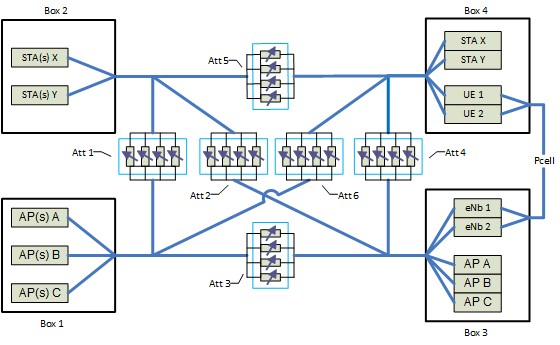
Wi-Fi Alliance LTE-U Coexistence Test Plan Testbed
- The test plan has five major sections that verify the LTE-U device under test:
- Selects a vacant or least used Wi-Fi channel
- Allows Wi-Fi devices to associate when LTE-U is in operation
- Adapts its airtime use as Wi-Fi channel load changes
- Has a limited impact on latency-sensitive Wi-Fi traffic
- Equally shares Wi-Fi traffic bandwidth
- Most of the test plan concentrates on tests with Wi-Fi networks operating in 802.11ac, 20 MHz bandwidth mode. The only tests operating with 40 MHz or 80 MHz Wi-Fi links are one test to check that the LTE-U equipment chooses a vacant channel and two tests that check that it uses least-used channels.
- The approved test bed Wi-Fi APs are business APs from HP / Aruba (APIN0204) and Ruckus Wireless (R710). The only approved consumer Wi-Fi AP is an ASUS RT-N66U (N900 class), used for some of the channel use checks described above.
- Tests are run with Wi-Fi link levels of -50 dBm, -67 dBm and -82 dBm. Not all tests are run at all three levels. In all cases, the LTE-U eNb transmit power is set at maximum.
While we should appreciate all the work and excess stomach acid involved in creating this plan, it clearly is not one focused on LTE-U’s impact on consumer Wi-Fi networks going forward. Most of those networks either operate in 80 MHz 802.11ac in 5 GHz, or will after trading up to 802.11ac gear. The only thing the Coexistence Test Plan verifies for consumer 11ac networks is that an LTE-U device will select a vacant or least-used channel.
Closing Thoughts
Call me naive, but I’m less cynical about LTE-U / LAA than when I started to write this article. True, Qualcomm has a lot at stake and I’ve referenced a lot of their material. But I think all the pushback from concerned Wi-Fi citizens (and product makers) has brought unlicensed LTE to a better place than where it started. Fair sharing with Wi-Fi appears to be baked into the technology cake and there are is a process in place, albeit optional for LTE-U and by no means perfect, to verify that unlicensed LTE will be a good Wi-Fi neighbor.
But the Coexistence Test is clearly not focused on verifying that consumer Wi-Fi gear won’t be negatively affected. And given the wide berth 802.11 specs give chip and end-device makers to, uh, innovate, it’s safe to say we won’t really know LTE-U’s impace on home networks until it moves in next door. What will happen when every network it sees is using 80 MHz bandwidth? And how about when it sees APs advertising non-standard 1024 QAM link rates or operating with 160 MHz or 80+80 MHz bandwidth? We’ll just have to wait and see.
For now, though, I think most of our home Wi-Fi networks will be safe from ill effects from LTE-U or LAA for the near future. But if AT&T or Verizon decide to add LTE-U to their U-verse or Fios boxes, then we’ll really see how well unlicensed LTE plays with Wi-Fi.
